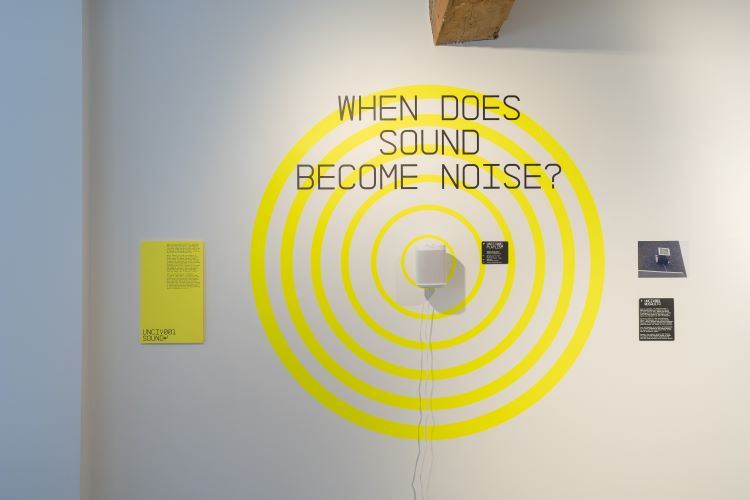Dn&co creates exhibition to explore “defensive design”

by IBRAHIM
Dn&co creates exhibition to explore “defensive design”

It is set to run at The London Festival of Architecture and aims to offer an impartial representation of hostile architecture.
Dn&co has conceived and designed the Uncivic Space exhibition, which explores defensive design at London Festival of Architecture. It has also designed the exhibition identity.
Defensive design, also referred to as hostile architecture, is a type of urban design that manipulates how a space can be used and sometimes dictates who can use it.
There is evidence of this architecture throughout history from medieval castles to the Great Wall of China and the Berlin Wall. However, according to Dn&co creative director Patrick Eley, hostile architecture is becoming “more insidious and less visible in public spaces.”
He adds, “What we see more recently are clever ways of using hostile architecture to change the way that a public space can be used. It makes you question how public the space really is.”
Eley, who oversaw the curation of the exhibition, explains how things like spikes which stop pigeons from nesting are more “visible and obvious”. In contrast, some are disguised as “something useful, like benches and armrests”, or not distinctly visible, like light and sound, he adds.
Dn&co attempts to cover a variety of interventions across the exhibition. Each section is signposted with a witty phrase linking to the content. For example, the title above the light section is ‘Now you see me, now you don’t’.
The five sections are noise, surveillance, light, pain and obstacles. Eley says he was particularly excited about designing the light and noise section because it presented the team with the challenge of exhibiting something that is “hard to visualise and show”.
In the light section, the display includes a blue light, which is normally used in public toilets and in tunnels, making veins less visible for drug users. In the noise section Eley also describes something called the mosquito, which omits “an unpleasant high pitched sound that older people can’t hear, but younger people can”.
The exhibition intends to highlight how most of this architecture is targeted at a particular group. Eley adds, “From a design perspective, hostile architecture is quite intelligent because it’s been designed for a very specific purpose.
“Look at the Camden bench – it won a lot of different awards but it was designed so that the homeless can’t sleep on it.” While he agrees that the designs are “less appealing as a social concept”, Eley argues that they are undeniably “fit for purpose”.
The more visual parts of the exhibition include fake CCTV cameras and signs reading things like “Smile, you’re on CCTV” and “beware of the dog”. These semiotics used in real life are a more complex kind of hostile architecture, according to Eley.
He says, “With graphic representations in place you sometimes don’t even need a real camera. It’s a similar idea with speed camera signs – the threat is enough.” Eley also mentions the similarities between this concept and the design of an 18th-century Panopticon – a circular prison where prisoners are being watched, but couldn’t see who was watching.
Dn&co also devised the design identity for the exhibition. Eley says that the goal was to create something “graphically arresting that would unify and harmonise all of these different elements of hostile architecture.”
The bright acid yellow and bright orange vinyl are meant to invoke hazardous imagery and “clearly meant to be disruptive”, says Eley. He adds that the mono typeface intends to give a sense of the “autocratic visual look” and appear “totally legible but not very friendly.”
Even the brochure that explains the exhibition is designed to be “purposely awkward and difficult to get in to”, taking the symbolism of the architecture even further, says the studio.
Though many people have a negative visceral response to defensive design, Dn&co wants to use the exhibition to encourage debate.
Eley says, “It’s very easy to say that defensive architecture is horrible and nasty but there are some examples where it actually could be useful. For example, stopping pigeons nesting in a very public area on a bridge will mean less clean up needed on the pavements.”
From a design point of view, he describes the architecture as “fascinating”. He says, “Think about the spikes that are used to stop pigeons nesting; there are hundreds of different versions of these things and they’re all slightly aesthetically different.”
The design team also say that creating something more outwardly hostile in the pain section was interesting for them, specifically “the word ouch in a drop shadow wave of spikes”.
Summing up a crucial purpose of the exhibition design, Eley explains how “we often don’t notice things that don’t directly affect us”. The Uncivic Space aims to bring this to our attention.
The exhibition is running for the duration of the London Festival of Architecture (until 26 June).
Recommended Posts

NB invites local designers centre stage for Vineyard Theatre rebrand
February 24, 2023

“AI revolution” will change way design studios look within three years
February 24, 2023

Rbl rebrands ZSL with ecosystem-inspired identity
February 23, 2023

